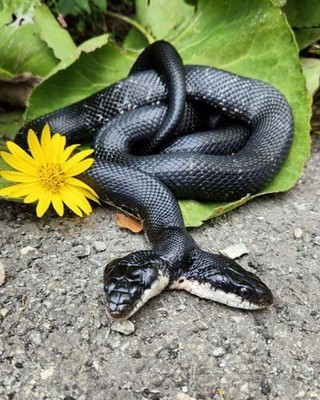– The unique biology and challenges of a two-headed western rat snake, Tiger-Lily, under the care of Saint Louis Zoo veterinarians.
– Veterinary advances and procedures applied to exotic and rare animals, specifically detailing the ovarian surgery on Tiger-Lily.
– The role of partnerships between zoos and conservation entities, using the Saint Louis Zoo and the Missouri Department of Conservation (MDC) collaboration as a case study.
– Insights into the survival and conservation of native wildlife, emphasizing western rat snakes in Missouri.
– Ethical considerations and the importance of wildlife management in zoological institutions.
The Saint Louis Zoo veterinarians recently undertook a remarkable surgical procedure on Tiger-Lily. This two-headed western rat snake has captured the attention of herpetologists and wildlife enthusiasts alike. Tiger Lily represents a biological phenomenon known as polycephaly, where an organism is born with more than one head. These extraordinary creatures offer a window into the complexities of vertebrate development and the potential for anomalies in the natural world.
Polycephaly occurs due to a failed twin separation, where the developing embryo does not split completely, resulting in conjoined twins. In Tiger-Lily’s case, this phenomenon resulted in a rare dual-head configuration. While such animals are sensational and engaging to the public, they face numerous physiological challenges that can impede their survival in the wild. For this reason, the intervention and care provided by zoological experts are critical.
The recent ovarian surgery conducted at the Saint Louis Zoo Endangered Species Research Center and Veterinary Hospital is a testament to the advances in veterinary medicine for exotic and rare species. The procedure’s success on March 11 showcases the skill and expertise of the zoo’s veterinary team and signals a step forward in the zoo’s efforts to manage the health of animals in their care effectively.
Tiger-Lily’s abnormal ovaries were carefully removed during the operation, requiring a highly skilled approach due to her unique anatomy. The meticulous planning and execution highlight the zoo’s capacity to address specialized veterinary needs. Post-surgery recovery is crucial, and the veterinarians closely monitor Tiger-Lily’s recuperation. Her resilience and the team’s diligent care suggest a positive prognosis for the snake.
Cross-institutional collaboration between the Saint Louis Zoo and the Missouri Department of Conservation is instrumental in such endeavors. This synergy allows for shared resources, knowledge, and a unified approach to protecting Missouri’s native species. Such partnerships are indispensable for advancing animal welfare and wildlife conservation efforts.
The impact of developmental abnormalities like polycephaly extends beyond individual animal care; it also sheds light on the broader issues of wildlife survival and adaptation. Western rat snakes, Pantherophis obsoletus, are a widespread and adaptable species in Missouri and play essential roles in the ecosystem as effective rodent population controllers. A snake-like Tiger-Lily, however, would likely face difficulties with mobility, feeding, and avoiding predators, sharply reducing her chances of survival in a natural habitat.
The management of Tiger-Lily also speaks to the ethical parameters of zookeeping and wildlife medicine. She receives specialized care that meets not just her physical health requirements but also her behavioral needs, a practice reflective of modern zoological principles emphasizing animal welfare and enrichment.
As zoos evolve into conservation and education centers, stories like Tiger Lilies engage the public in discussions about biodiversity and the importance of preserving our natural world. Her tale is a poignant reminder of nature’s vulnerabilities and the commitment required to sustain the myriad of life forms sharing our planet.
The narrative of Tiger-Lily and her surgical journey highlights the intersection of veterinary science, wildlife management, and conservation education. It emphasizes that while zoos are often seen as locales for family entertainment, at their core, they are scientific institutions dedicated to the care, understanding, and preservation of our world’s fauna. Through active engagement with the public and transparent sharing of their conservation efforts, zoos like the Saint Louis Zoo drive awareness and support for saving common and rare species.
Zoos and conservation organizations illustrate the importance of each animal in the tapestry of biodiversity by sharing the story of Tiger-Lily. The Saint Louis Zoo’s efforts epitomize the dedication and resolve zoos must have to fulfill their roles as wildlife stewards and environmental education champions. The expertise and commitment demonstrated by the zoo’s veterinary team, supported by fruitful partnerships with conservation bodies like the MDC, are essential threads in the broader conservation narrative that will continue to shape the future of species like the western rat snake for generations to come.
*****
Source Description
Saint Louis Zoo veterinarians performed surgery this month on Tiger-Lily, a unique two-headed western rat snake under the care of the @moconservation.
On March 11, veterinarians removed Tiger-Lily’s abnormal ovaries at the Saint Louis Zoo Endangered Species Research Center and Veterinary Hospital. The procedure was successful, and she is doing well in recovery.
“The Saint Louis Zoo and MDC have a long history of partnering to care for Missouri’s native wildlife, and we are happy to have played a part in caring for this exceptional animal,” said Dr. Chris Hanley, Director of Animal Health at the Saint Louis Zoo.
The two-headed snake was discovered in Stone County in 2017 and named “Tiger-Lily” by the family who found the rare reptile. Tiger-Lily is a pair of conjoined identical snake twins that were never completely separated. Such snakes are rarely seen in the wild, partly because snakes born this way have a low survival rate. Western rat snakes are non-venomous and a common native species in Missouri.
Read more from MDC at the link in the bio.

